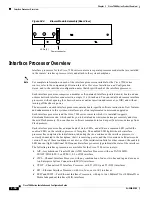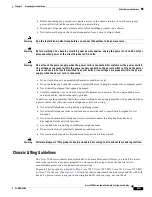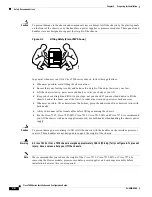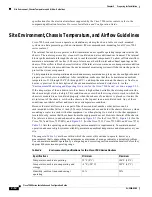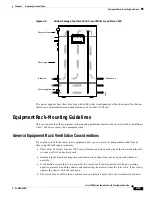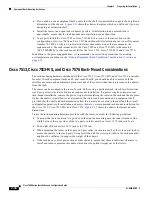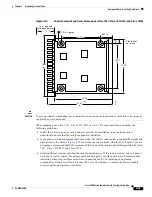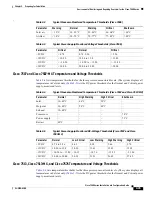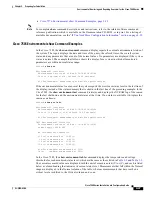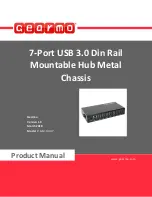
2-12
Cisco 7500 Series Installation and Configuration Guide
OL-5008-03 B0
Chapter 2 Preparing for Installation
Site Environment, Chassis Temperature, and Airflow Guidelines
specifications for the electrical interfaces supported by the Cisco 7500 series routers, refer to the
companion publication Interface Processor Installation and Configuration Guide.
Site Environment, Chassis Temperature, and Airflow Guidelines
Cisco 7500 series routers can operate as standalone systems placed on a table or as rack-mounted
systems in a data processing or lab environment. (We recommend rack-mounting for all Cisco 7500
series routers.)
The internal fan or blower operates so that it maintains an acceptable operating temperature inside the
chassis. The router requires a dry, clean, well-ventilated, and air-conditioned environment. The internal
blower pulls ambient air through the chassis to cool the internal components. To allow sufficient airflow,
maintain a minimum of 2 inches (5.08 cm) of clearance at both the inlet and exhaust openings on the
chassis. If the airflow is blocked or restricted, or if the inlet air is too warm, an overtemperature condition
can occur. Under extreme conditions, the environmental monitoring system will shut down the power to
protect the system components.
To help maintain normal operation and avoid unnecessary maintenance, plan your site configuration and
prepare your site before installation. After installation, make sure that the site maintains an ambient
temperature of 32 through 104°F (0 through 40°C), and keep the area around the chassis as free from
dust as is practical. For a description of the environmental monitor and status levels, see the
“Environmental Monitoring and Reporting Overview for the Cisco 7500 Series” section on page 2-22
.
If the temperature of the air drawn into the chassis is higher than desirable, the air temperature inside
the chassis might also be too high. This condition can occur when the wiring closet or rack in which the
chassis is mounted is not ventilated properly, when the exhaust of one device is placed so it enters the
air inlet vent of the chassis, or when the chassis is the top unit in an unventilated rack. Any of these
conditions can inhibit airflow and create an overtemperature condition.
Because the inlet air flows into one part of the chassis and out another, other devices can be
rack-mounted with as little as 1 inch (2.54 cm) of clearance above and below the chassis. However, when
mounting a router in a rack with other equipment, or when placing it on a table with other equipment
located close by, ensure that the exhaust from other equipment does not blow into the inlet of the chassis.
The inlet air is drawn in and exhausted as shown in
Figure 2-7
(for the Cisco 7505),
Figure 2-8
(for the
Cisco 7507 and Cisco 7507-MX), and
Figure 2-9
(for the Cisco 7513, Cisco 7513-MX, and Cisco 7576).
Table 2-1
lists the operating and nonoperating environmental site requirements. To maintain normal
operation and ensure high system availability, maintain an ambient temperature and clean power at your
site.
The ranges in
Table 2-1
are those within which the router will continue to operate; however, a
measurement that is approaching the minimum or maximum of a range indicates a potential problem.
You can maintain normal operation by anticipating and correcting environmental anomalies before they
approach the maximum operating range.
Table 2-1
Environmental Specifications for the Cisco 7500 Series Routers
Specifications
Minimum
Maximum
Temperature, ambient operating
32°F (0°C) 104°F (40°C)
Temperature, ambient nonoperating and
storage
–4°F (–20°C) 149°F (65°C)
Humidity, ambient (noncondensing)
operating
10% 90%

